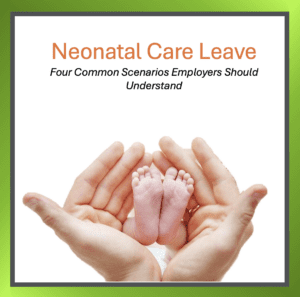Neonatal Care Leave: Four Common Scenarios
The introduction of statutory neonatal care leave this April marks a significant change in employment law that requires immediate attention from HR departments and business leaders. This new legal entitlement provides crucial support for parents during what can be an extremely challenging time.

Caring hands cradle a newborn’s feet, symbolising the need for employers to understand neonatal care leave scenarios.
Understanding the New Rights
Neonatal care leave gives parents the right to take protected time off work when their newborn requires specialist medical care. With this legislation now in effect, employers must ensure their policies and procedures align with these new requirements to maintain legal compliance and support employees appropriately.
Four Common Scenarios Explained in Detail
Scenario 1: Determining Employee Eligibility
The Situation: An employee’s baby is born prematurely at 32 weeks and requires a 3-week stay in the neonatal unit.
Key Considerations:
- The employee must have 26 weeks of continuous service with your organisation
- They must remain employed throughout the leave period
- The child must be under 28 days old when admitted to neonatal care
- The hospital stay must be for a minimum of 7 consecutive days
- Both parents may be eligible for leave, including adoptive and intended parents in surrogacy arrangements
Practical Application: HR should proactively communicate with employees about this entitlement during pregnancy or parental leave discussions, rather than waiting for employees to request it during what will be a stressful time.
Scenario 2: Navigating Tier 1 and Tier 2 Leave Entitlements
The Situation: An employee’s newborn requires an extended stay in neonatal care that crosses between both tiers of entitlement.
Key Considerations:
- Tier 1 Leave: Applies when a newborn spends 7-69 continuous days in neonatal care, providing one week of leave for each week the baby remains in care
- Tier 2 Leave: Activated when neonatal care extends beyond 70 days, providing additional protected leave
- Pay structures differ between tiers, with statutory rates applying similar to other parental leave provisions
- Leave can be taken immediately following the neonatal stay or within 68 weeks of the birth
Practical Application: Employers need systems to track the duration of neonatal care to accurately calculate entitlements and ensure proper payroll processing for each tier.
Scenario 3: Managing Notice Requirements and Documentation
The Situation: An employee’s baby unexpectedly requires neonatal care after a seemingly routine birth.
Key Considerations:
- Initial notification can be informal due to the urgent nature of neonatal admissions
- Employees must provide formal written notice within 28 days including:
- The date of the child’s birth
- The date of admission to neonatal care
- The expected duration of care if known
- Employers can request reasonable evidence such as admission documents
- Subsequent updates may be necessary for extended stays
Practical Application: Create clear documentation processes that balance compliance needs with sensitivity to the employee’s situation, avoiding unnecessary administrative burden during this stressful time.
Scenario 4: Supporting Employees Returning to Work
The Situation: An employee is returning to work after taking extended neonatal care leave following their baby’s 12-week stay in intensive care.
Key Considerations:
- Employees retain the right to return to the same job after neonatal leave
- If neonatal leave is combined with other parental leave exceeding 26 weeks, different return-to-work rules may apply
- Employers should consider phased returns or temporary adjustments
- Protection from dismissal or unfavourable treatment related to neonatal leave
- Ongoing support needs, including potential flexible working requests
Practical Application: Develop a structured return-to-work process specifically for neonatal leave situations, including pre-return discussions, wellbeing check-ins, and manager training on supporting employees with children who may have ongoing medical needs.
Why This Matters
Beyond compliance, how your organisation handles neonatal care leave reflects your company values and affects employee retention, engagement, and wellbeing. Parents experiencing the stress of having a child in neonatal care need clear information and supportive policies.
Take Action Now
Don’t wait until faced with your first neonatal leave request to understand these regulations. Download this guide today to ensure your organisation is fully prepared to navigate these new requirements with confidence.
At Tick HR Solutions, we’re committed to helping Lincolnshire businesses implement compassionate and compliant HR practices.
